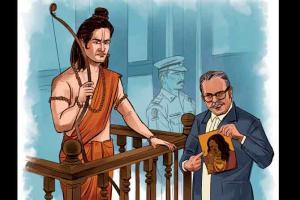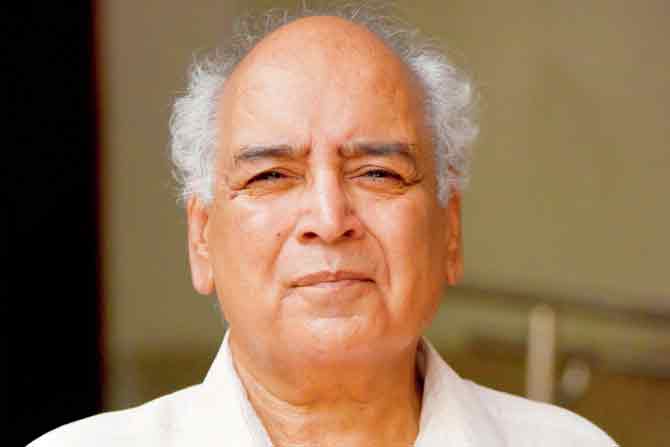A unique book combines mythology and criminal law, putting characters from the Ramayana under the lens of the IPC, leaving them to defend their actions

An artist's depiction of Lakshman stating his arguments on why he cut off Surpanakha's nose. Illustration/Uday Mohite
The burden of an epic is that each succeeding generation will interpret it from the lens of its own morals and viewpoint. In recent years, the Ramayana and Mahabharata have been viewed from several lenses—feminist, Dalit, genocide, and from the perspectives of their traditional antagonists. However, what if one viewed them from their very own lens, i.e. dharma, but not by its ancient definition. Rather, from what it means in 2020?
Journalist Anil Maheshwari and his nephew advocate Vipul Maheshwari have applied perhaps the most modern equivalent of dharma i.e. the Indian Penal Code. And, in the witness box, presenting their case stand is everyone, from Indra, Ahalya and Vishwamitra to Sita, Lakshman and, of course, Ram himself.

Anil Maheshwari
Anil, 71, says the idea first came to him in 1999 when he was posted at Kalimpong. "I met a gentleman in Kalimpong, who shared the idea 'what if there was an IPC case on Raavana for kidnapping Sita'? There was a judge present during the conversation, who pointed out the relevant sections of the IPC under which the prosecution could be launched." Like any good journalist, Anil made his notes and kept the conversation in mind. Later, he wrote to well-known mythologist Bibek Debroy, on the 'Case Against Raavana', who responded within a few hours saying, "It's a great idea, why don't you write a book on this?"

Sage Gautama and Ahalya
The arguments made by different characters in Ramayana Revisited: An Epic Through a Legal Prism (published by Bloomsbury) are quite interesting. Take for instance the first case: that of Manthara, Queen Kaikeyi's attendant, who has rarely been seen with sympathy. Charged with treason and causing King Dasharatha's death, her counsel argues: "Manthara was not responsible for King Dasharatha's death either. There needs to be an act intending towards death or an intention of causing bodily harm that could result in death to be liable for murder u/s 302 or culpable homicide not amounting to murder u/s 304 of the IPC. This kind of causation is too remote to be punishable."
How the book argues for Manthara, Ahalya and Sita—against her banishment from Ayodhya by Rama—is perhaps the legal interpretation we all need voiced in our epics. Where Ahalya asks how Brahma, her creator, could give her hand in marriage to Sage Gautama, the man who raised her, she argues for both the agency of women and their sexual desires. "Brahma should have taken my tender age and my childhood relationship with Sage Gautama in view. Such a marriage is prohibited under law. Second, Sage Gautama shouldn't have agreed to marry me as he had raised me as his child." The marriage would have been void under Section 3(g) of the Hindu Marriage Act.

Manthara and Queen Kaikeyi. Illustration/Bandana Paul courtesy Ramayana Revisited: An Epic Through a Legal Prism
While the idea of the book was born two decades ago, the research was conducted over the last two and a half years. Of course, as a former journalist, he is careful to state facts. "It's not like this was the only thing I was working on." Anil pored over the Ramayana by Rajagopalchari, and picked the 16 characters he'd include in the book. The research—Anil says he also referenced works by several mythologists such as Anand Neelakanthan, Kavita Kane and Devdutt Pattanaik, who have revisited the Ramayana in the last two decades—also introduced him to lesser known characters of the epics, such as Shambhuka and Vedavati. Meanwhile, Vipul identified the relevant sections of the IPC that the cases could be argued under. But, it's not just humans. A case is also made for Jatayu under the Wildlife Protection Act.
Anil says, "This is meant as light reading." Yet, the book achieves a more difficult challenge, making the general public aware of laws. For instance, Rama—whose abandonment of Sita, has been a major sore point for many of those who revere him—the book argues, "should have actually punished the launderer who was engaged in rumour-mongering for defamation u/s 499 of the IPC", instead of punishing Sita based on hearsay.

Vipul Maheshwari
Where Rama argues: "I sent [Sita] to a great sage's ashram. Sage Valmiki could take care of her perfectly. Hence, I set an ideal example of an astute human being. The act of banishment shows how the king should be willing to forsake his own comforts and attachment for the sake of his praja". Sita says, "The moment you are asked to prove that you belong to only someone, you cease to belong to them genuinely."
The cases, interestingly, do not end with any judgment. Anil says his publishing editor at Bloomsbury asked him about it. He responds with: "Who am I to pass judgment?" Time, perhaps.
Keep scrolling to read more news
Catch up on all the latest Mumbai news, crime news, current affairs, and a complete guide from food to things to do and events across Mumbai. Also download the new mid-day Android and iOS apps to get latest updates.
Mid-Day is now on Telegram. Click here to join our channel (@middayinfomedialtd) and stay updated with the latest news
 Subscribe today by clicking the link and stay updated with the latest news!" Click here!
Subscribe today by clicking the link and stay updated with the latest news!" Click here!









